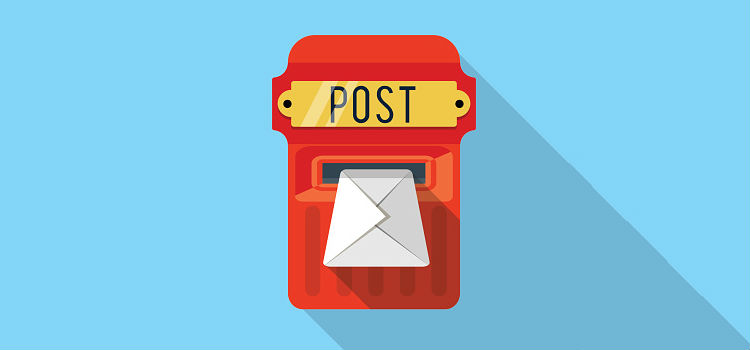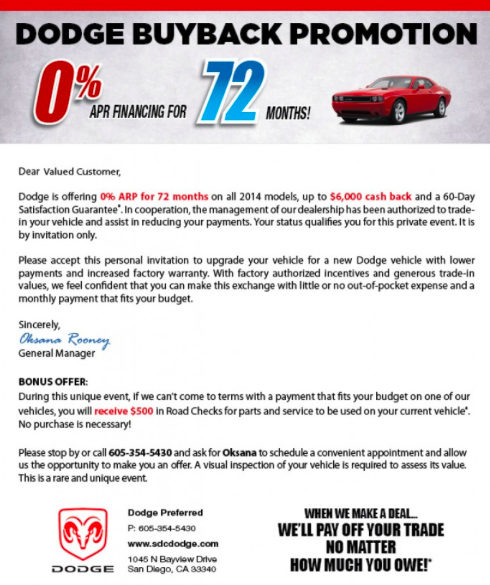Despite popular belief, direct mail marketing isn’t extinct. In fact, U.S. organizations spent $46 billion on direct mail in 2014, that’s up from $44.8 billion the year before.
In addition to digital marketing tactics and a loyalty program, of course, direct mail also provides an opportunity to attract and retain customers. Is it right for your business? Take a look at the pros and cons of direct mail marketing below to see if it’s a viable option for your company:
Pro: Target a niche audience
In general, the more targeted your marketing efforts, the better success you’ll have. With direct mail marketing, you can send information to a select group that’s interested in your product and increase your chance of closing a deal.
Of course, curating this list can be tricky. Some businesses collect customer information including addresses, demographics and buying behaviors. With that kind of information, you can target previous customers that you’d like to upsell, like this dealership does with an invitation-only, VIP event for customers that want to trade in their previously purchased vehicle.
If you don’t have that kind of information, you’ll have to rent a list of potential customers. There’s still potential in a rented list, but there are costs associated.
Pro: Provide detailed information
Direct mail pieces give a lot of room to work with (front and back!), hence you can also give customers a lot more information. A detailed letter, event invite, or flyer, for example, can outline the benefits of your company, its local history and provide a special deal for new customers.
You have a chance to provide in-depth information that can’t be conveyed in a text, Tweet, Facebook ad, or even an email. You can see here, the San Francisco Art Exchange was able to relay a lot of information about its new Beatles exhibit in this greeting card:
Pro: Easily track your response rate
Businesses can easily plan for redemption tracking. For example, asking customers to bring in a coupon to redeem a deal, including a promo code or barcode specifically associated with your print piece, or having the recipient fill out a pre-numbered application that’s included in the mailing, are common ways to track the success of a campaign.
If you know your response rates, you can figure out your return on investment.
Con: Costs can add up
Direct mail involves four main components: the list, the offer, the creative and the delivery.
You can send promotional information to a list of contacts that you’ve gathered, or rent a list from a third party vendor. If you rent a list, you’re looking at $50-250 per one thousand names.
The mailing requires an offer, or an incentive of some sort. To make it attractive, and worth a customer’s time, the offer has to be enticing. That means the offer could cut into your bottom line. Businesses have to create an offer that lands the client without decreasing profits.
Whatever your offer is, you’ll need to present it in a visual way. Whether you’re going to craft a sales letter or a postcard, you’ll have to create the materials. If you plan to create them in-house, be sure to quantify how much time is spent in doing so. If you have a design team create the materials, add the hard cost into your equation.
Research shows an oversized envelope gets the best response rates at 5 percent, a postcard comes in at 4.25 percent and catalogs achieve 3.9 percent. Of course, the larger the materials needed, the more expensive it is to create and mail.
That brings us to the final expense: Postage. With rising postage costs, every business has to crunch the costs.
While expenses can certainly add up, your return on investment could outweigh the costs. Before you pull the trigger on a direct mail campaign, use this calculator to see if the benefits outweigh the costs.
Con: Response rates are typically low
Response rates for direct mail are fairly low. Some sources put direct mail response rates below two percent, while others suggest rates around 3.7 percent.
In additional to low response rates, some recipients lump direct mail in with junk mail. If they don’t recognize the return address or aren’t expecting any information from a business, your mailing could get tossed. Research shows tat 44 percent of direct mail is never opened. That means the time and money spent to create and send is never even accessed, it’s just chucked in the garbage.
Have you used direct mail marketing? How has it worked for your business? Share your thoughts with others in the comment section below.







Thanks for explaining the pros and cons us using direct mail marketing. I can see why people continue to use this method of advertising! It is cool that you can advertise to a very specific niche of people who are most likely to become customers. It is good to know that this method can cost a lot. Is direct mailing better for larger businesses more than small businesses? Thanks for the info!
I think that direct mail can be useful depending on the type of business that you have and the message that you are sending out. Great list of pros and cons, thanks for sharing!
I think for many companies, being able to target a niche market is the life of their marketing strategy. Like with the car dealerships you mentioned, repeat business is extremely beneficial, and any way you can get it is worth the cost. Any business that needs to reach out to existing or past customers should get in contact with a direct mailing company and see the benefits.
I feel like there really can be a lot of benefits that come with sending actual mail. Even though it can be more expensive than email, I feel like there is something more memorable for people when they get something in the mail instead of just another email. I also think that is a good point you make about it being easy to track your response rate. Emails can be pretty difficult to track something like that.